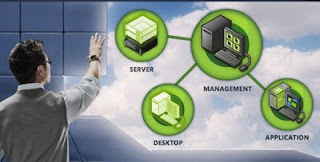
Microsoft provides an end-to-end suite of virtualization products and technologies — all tied together by a centralized management system.
Server Virtualization
Hardware Virtualization uses software to create a Virtual Machine (VM) that emulates a physical computer. This creates a separate OS environment that is logically isolated from the host server. By providing multiple VMs at once, this approach allows several operating systems to run simultaneously on a single physical machine.
Rather than paying for many under-utilized server machines, each dedicated to a specific workload, server virtualization allows those workloads to be consolidated onto a smaller number of more fully-used machines.
Benefits
- Consolidates multiple, under-utilized physical servers on a single host, running Virtual Machines
- Reduces workforce/space/kilowatt by leveraging virtualization for server consolidation and agility
- Helps save money because less managing, less space and less kilowatt hours are needed
Server Virtualization
Hardware Virtualization uses software to create a Virtual Machine (VM) that emulates a physical computer. This creates a separate OS environment that is logically isolated from the host server. By providing multiple VMs at once, this approach allows several operating systems to run simultaneously on a single physical machine.
Rather than paying for many under-utilized server machines, each dedicated to a specific workload, server virtualization allows those workloads to be consolidated onto a smaller number of more fully-used machines.
Benefits
- Consolidates multiple, under-utilized physical servers on a single host, running Virtual Machines
- Reduces workforce/space/kilowatt by leveraging virtualization for server consolidation and agility
- Helps save money because less managing, less space and less kilowatt hours are needed
No comments:
Post a Comment